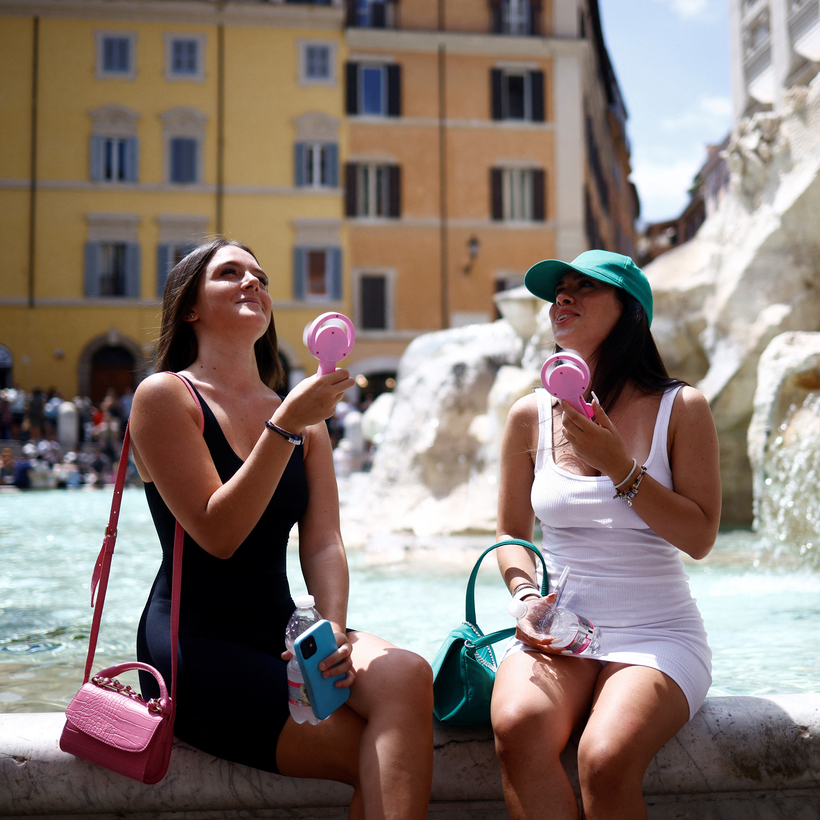This week the cool, gushing water of the Trevi Fountain seemed like a desert oasis to the hordes of tourists staggering out of Rome’s narrow, blisteringly hot streets.
This has made life harder for the police officers stationed at the fountain to stop visitors throwing themselves in.
“We tolerate people dipping a hand in to wet their brow, otherwise we would have to shut the place down,” one officer said. “But we draw the line at feet — there are rules.”
Eyeing the 18th-century fountain, Dan Tuttle, 32, a British tourist, said he was sorely tempted to follow the example of the Swedish actress Anita Ekberg, who waded through the water in the 1960 film La Dolce Vita.

“I know I can’t, but I would love to dive in,” Tuttle said. With temperatures above 35C thanks to the anticyclone from Africa dubbed Cerberus, Rome was sweating through the kind of heat normally seen in August, when the city shuts down and locals flee to the beach, leaving it to hapless tourists.
The problem is that this is July and Romans are still at work, forced to share the hell with foreigners. Which is why the air-conditioned shopping malls on the edge of town are full of locals walking their dogs, business at hospital emergency departments is up 15 percent as people keel over in the heat and supermarkets are selling out of watermelon.
“We tolerate people dipping a hand in [the Trevi Fountain] to wet their brow, otherwise we would have to shut the place down.”
The town hall has weighed in on shopping lists, warning Romans not to drink alcohol, fizzy drinks or coffee, because they just make you feel worse, while advising people to dress in linen and stay indoors between 10am and 6pm.

At home, I have been rising at 6am and flinging open the windows to draw in any cool air before shutting them by 8am to keep out the rising heat, as well as closing the external shutters Roman houses have to stop the sun scalding the panes.
Arriving at work, I am careful to park my moped on cobbles rather than on asphalt that may melt during the day, causing it to sink into the black goo and topple over. Taking refuge at my desk, I write about how temperatures in Sicily and Sardinia are forecast to rise again next week as high as 47C, close to the 48.8C (119.8F) record European temperature set in Sicily two years ago.
The soaring temperatures will be due as Cerberus — named after the three-headed dog that guards the underworld in Greek mythology — gives way to the more ferocious Charon, named after the boatman ferrying the dead across the Styx.

This raises the question, who has been making up these names so keenly adopted by newspapers? Because they make great headlines and give journalists a chance to show off their knowledge of the classics.
Whoever it is, the result is that Italy’s heat waves sound a lot more sophisticated than hurricanes in the US, which were given the supremely dull names Martin, Owen and Walter last year by the World Meteorological Organization and the American National Hurricane Center.
I rang Italy’s meteorological and climatology agency but Carlo Cacciamani, the director, said the names had nothing to do with them and he did not really approve. “Cyclones get names because they have life spans but this heat is caused by the African anticyclone, which is always there, even if it moves,” he said.
Italy’s heat waves sound a lot more sophisticated than hurricanes in the US, which were given the supremely dull names Martin, Owen and Walter last year.
Inquiries in meteorological circles led me to Antonio Sanò, the wily head of a private weather forecasting site. “It’s me,” he confessed, explaining how he had been inspired by Dante Alighieri’s 14th-century epic The Divine Comedy, in which the author meets Cerberus and Charon during his descent to hell. “I had a great Dante teacher at school and I knew we needed something hellish to describe this heat,” he said.
Sanò realized the instant appeal of his names when he first used Cerberus on his site to describe a heat wave in 2012 — and the Italian news agency Ansa immediately adopted it. The media has been lapping it up ever since.
This summer, after Charon, Sanò said he would dub the next heat wave Minos, the king of Crete who became a judge in the underworld after his death and used his tail to indicate the circle of hell to which a soul was consigned. “After that, the furthest we go is Lucifer, but we are keeping that for the end of the summer,” Sanò said.
Headline writers have been warned.
Tom Kington is a Rome-based journalist

